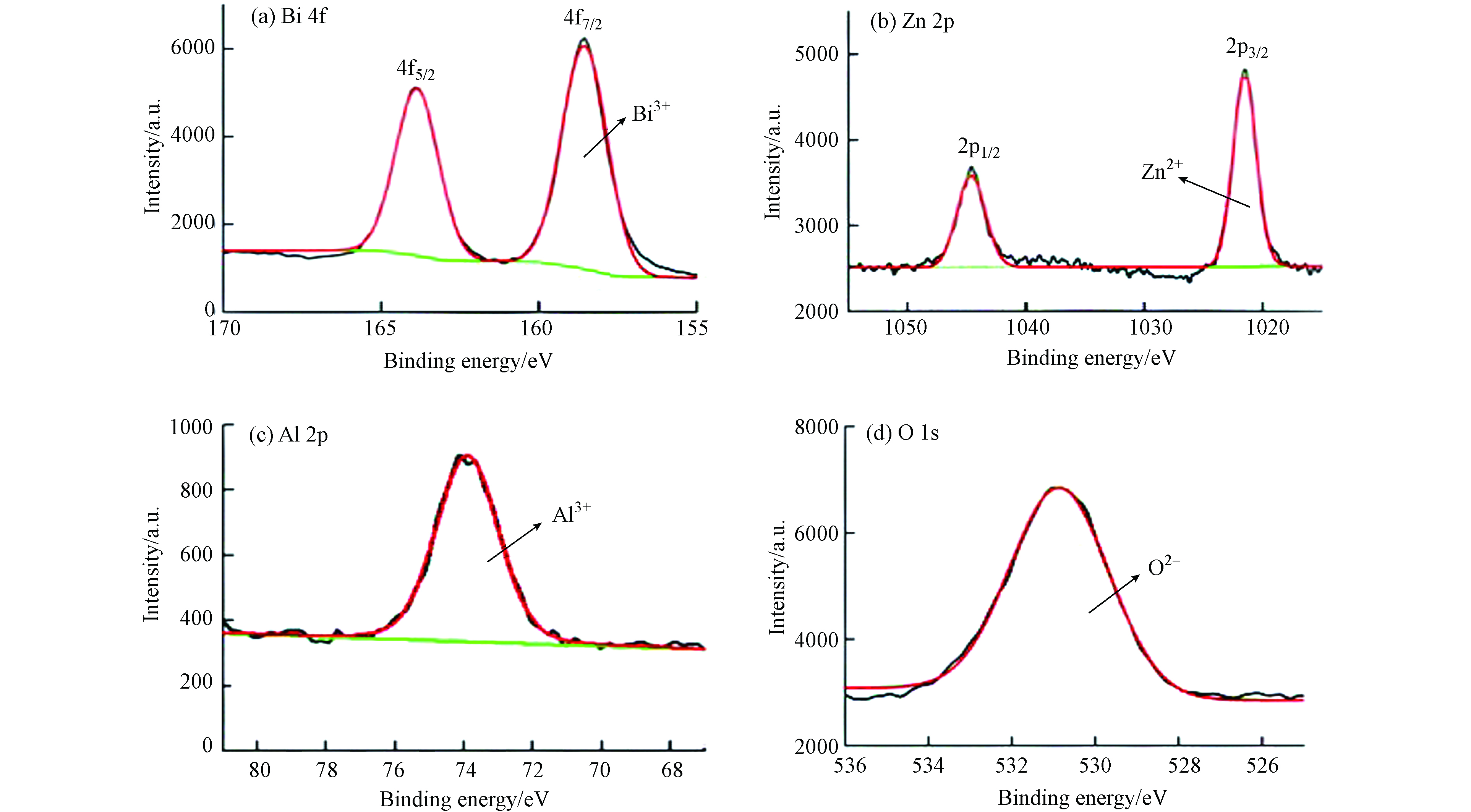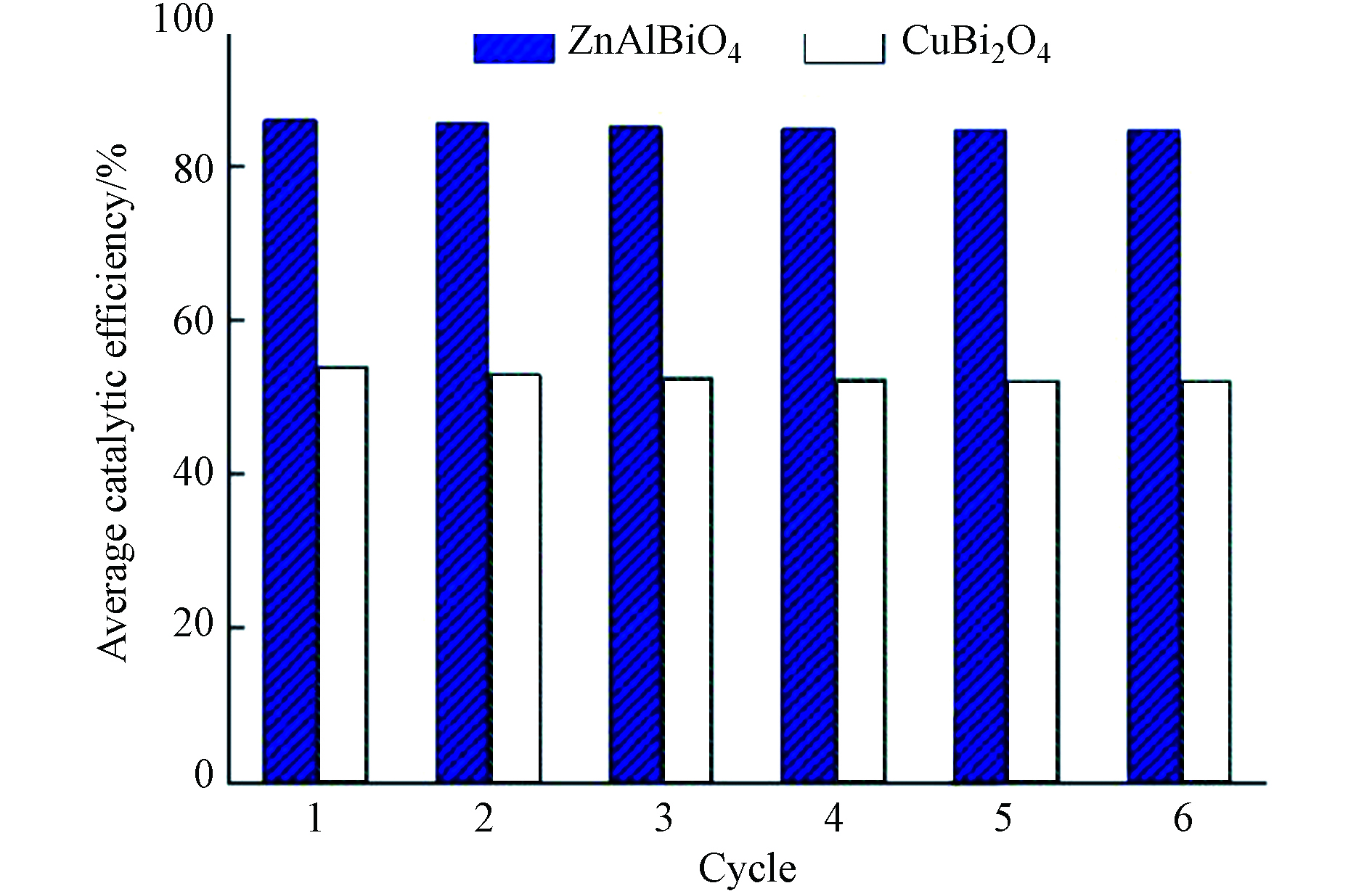-
自1972年Fujishima和Honda首次发现光催化效应[1]以来,光催化作为一种环境友好型技术,在挥发性有机物(VOCs)治理领域得到了快速发展[2]. 光催化治理VOCs具有反应可控、条件温和、无二次污染等优点[3].
Ti、Bi、Zn、Sn、Al等氧化物是常用的半导体光催化材料[4-7],其中TiO2由于廉价易得、无毒无害等优点,应用最为广泛. 但这些金属氧化物带隙较宽,且光生电子空穴复合率高,光催化效率比较低. 以TiO2为例,禁带宽度为3.2 eV,只能利用波长低于380 nm的紫外光,该部分紫外光在太阳光中占比不到5%;此外TiO2稳定性不佳,在使用过程中易发生光腐蚀导致性能下降. 光催化效率和稳定性提升的常用方法有贵金属掺杂[8]、表面形貌控制[9]和复合改性[10]等,但这些方法制备过程复杂、成本高,不利于推广应用. 开发制备过程简单、光催化效率和稳定性好、适宜在可见光下应用的光催化剂具有广阔应用前景.
尖晶石型化合物AB2O4为立方晶或者四方晶系,其中的A—O和B—O键为强离子键,稳定性和耐光腐蚀性好;同时表面有大量电子空穴对,光催化性能优异. 尖晶石型光催化剂是一种理想的便于推广应用的材料. 尖晶石型铋系光催化剂,由于O的2p电子轨道会与Bi 的6s2 价带发生杂化,可进一步缩短带隙、提高可见光响应性能,成为近些年的研究热点,其中以CuBi2O4最为常见[11],但纯相的CuBi2O4化学亲和能较低且光生电子-空穴易复合,光催化性能仍有待提升.
铋系光催化剂的铋源一般为Bi(NO3)3·5H2O,该物质只有在强酸条件下才能避免水解产生碱式盐沉淀,所以常规溶胶凝胶法不适用于铋系光催化剂的制备,常用方法有共沉淀法[12]和水热法[13]. 本文通过一种新颖的酯化溶胶凝胶法制备出了尖晶石型铋系的CuBi2O4和ZnAlBiO4可见光光催化剂,制备过程不额外添加水作为溶剂,避免了Bi(NO3)3·5H2O的水解. 此外,将上述催化剂分别负载在蜂窝陶瓷上,对比两者光催化降解乙醛废气性能,为室内空气净化提供理论指导.
-
将稳定剂丙酮、羟基供体丙三醇和硝酸按照体积比3:2:2混合制备成溶胶,首先将丙酮和丙三醇在锥形瓶中混合均匀后缓慢加入120 mL硝酸,30 ℃下磁力搅拌10 min得到前驱体溶液. 根据尖晶石化学通式AB2O4,取0.06 mol Cu(NO3)2·3H2O和0.12 mol的Bi(NO3)3·5H2O缓慢加入上述前驱体溶液中形成前驱体溶胶,30 ℃下磁力搅拌30 min后,升温至50 ℃继续搅拌直至无色透明的前驱体溶胶变为黄色液态凝胶. 将液态凝胶120 ℃恒温干燥2 h得到干凝胶,置于马弗炉中热处理,升温速率为5 ℃·min−1,烧结温度为550—600 ℃,保温1 h. 经玛瑙研钵充分研磨后,得到纯相CuBi2O4尖晶石结构光催化剂粉体.
将二价金属原料Cu(NO3)2·3H2O等化学计量替换为Zn(NO3)2·6H2O,同时将三价金属原料Bi(NO3)3·5H2O一半化学计量替换为Al(NO3)3·9H2O,按照上述方法,制备出ZnAlBiO4尖晶石结构光催化剂粉体.
为进一步验证上述光催化剂的实际应用效果,将300目堇青石蜂窝陶瓷浸渍于上述的黄色液态凝胶中超声振荡30 min后沥干至无液膜,然后120 ℃恒温干燥2 h得到附着干凝胶的蜂窝陶瓷,同上操作得到负载CuBi2O4和ZnAlBiO4光催化剂的蜂窝陶瓷,通过反复浸渍可以进一步提高光催化剂在蜂窝陶瓷上的载量. 以下同一种材料的光催化剂粉体和对应负载在蜂窝陶瓷上的催化剂均为同一过程制备.
-
制备的光催化剂粉体样品晶相结构通过X-射线衍射分析进行测定,Cu 靶,λ = 0.1546 nm,扫描角度4 ℃·min−1,20—60 °扫描. 催化材料的表面形貌和粒径通过JSM-6460LV高精度扫描电子显微电镜进行观测,同时通过其附带的X-射线能量散射谱分析仪测定催化剂的元素组成和含量. 催化剂表面元素组成及化学态,通过X-射线光电子能谱分析仪进行分析,其中光子能量hν = 1253.6 eV. 催化剂的紫外可见光响应性能通过紫外可见漫反射光谱分析仪进行测定,光谱扫描范围为200—1100 nm.
-
参照《光催化空气净化材料性能测试方法》(GB/T23761—2009)选择乙醛模拟VOCs废气,实验装置包含配气系统、催化及尾气吸附系统和检测系统,如图1所示.
配气系统用于配置反应气,包含氧气瓶、乙醛标气瓶、调节阀、转子流量计和缓冲罐,控制反应气气体流量为90 L·min−1、乙醛浓度为100 mg·m−3. 催化及尾气吸附系统包含光催化反应器和活性炭尾气吸附系统,其中光催化反应器内放置5层100 mm×100 mm×10 mm负载CuBi2O4和ZnAlBiO4光催化剂的蜂窝陶瓷,陶瓷片上下间隔100 mm,两片陶瓷中间平行放置2根主波长为420 nm的8 W管状荧光灯,模拟可见光源;活性炭尾气吸附系统用于残留废气的净化. 检测系统为带有氢火焰离子检测器的气相色谱仪,用于测试光催化反应器出口乙醛浓度,同时采用气体注射器离线取样,在装有TCD检测器的气相色谱仪上测试二氧化碳浓度,用以评估乙醛矿化效率.
首先将负载光催化剂的蜂窝陶瓷150 ℃恒温烘干2 h,用以去除吸附物质;光催化实验前先进行暗吸附实验,消除吸附对光催化实验的影响,暗吸附实验须在包裹锡纸的昏暗环境中进行,连续通入乙醛反应气直至光催化反应器进出口浓度基本保持一致,每隔20 min测试出口乙醛浓度;暗吸附实验结束后进行光催化实验,继续稳定通入乙醛反应气,取消锡箔纸,连通荧光灯,每隔20 min测试出口中乙醛和二氧化碳浓度,反应持续3 h.
-
乙醛吸附率由式(1)计算:
其中,A为乙醛吸附率,%;C0为反应气中初始乙醛浓度,mg·m−3;Ca为暗吸附实验时反应器出口乙醛浓度,mg·m−3.
乙醛光催化净化效率由式(2)计算,乙醛平均光催化净化效率以光催化实验后2 h算术平均值计:
其中P为乙醛光催化净化效率,%;C0为反应气中初始乙醛浓度,mg·m−3;Cb为光催化实验时反应器出口乙醛浓度,mg·m−3.
乙醛光催化矿化率由式(3)计算:
其中M为乙醛光催化矿化率,%;Cc为反应器出口二氧化碳浓度,mg·m−3;C0和Cb同上式.
-
制备的CuBi2O4和ZnAlBiO4光催化剂粉体样品X-射线衍射分析(XRD)结果见图2. 样品XRD谱图三强峰均较为尖锐,表明其结晶度良好. 通过与JCPDS 的XRD物相标准卡片对比可知,CuBi2O4样品特征峰与编号为#42-0344的标准谱图一致,晶体为四方结构,属于P4/ncc空间群,晶胞轴长(长宽高)分别为0.8499、0.8499 、0.5797 nm. ZnAlBiO4样品则无标准谱图对应. 相比于CuBi2O4样品,ZnAlBiO4样品将其中Cu全部替换为Zn,50%含量的Bi替换为Al,其中Zn2+离子半径(0.074 nm)与Cu2+离子半径(0.073 nm)基本相当,但Al3+离子半径仅为0.0535 nm,远小于Bi3+离子半径(0.103 nm),所以会造成ZnAlBiO4晶体结构较CuBi2O4发生较大变化. 通过Jade软件分析结构相似的物质,根据XRD数据,结合晶面间距计算公式,可以试算出ZnAlBiO4晶体结构为四方结构,晶胞轴长(长宽高)分别为0.3867、0.3867 、1.369 nm. 推测ZnAlBiO4中可能含有Bi、Al、Zn的氧化物,但与标准卡片的对应性均不好,而相比于CuBi2O4的谱图,ZnAlBiO4的XRD谱图峰位置向高角度偏移,推测是Zn原子填在八面体空隙导致的,试算晶胞长宽明显变窄也印证上述结论.
上述元素的引入造成样品晶格畸变、能带结构改变,有利于光生电子和空穴的分离,提高其可见光响应性能和光催化活性.
-
制备样品的表面形貌(SEM)和X-射线能量散射谱分析(EDS)结果见图3. 可知,样品粒径为纳米到亚微米量级,分散性良好,但也存在一定程度的团聚,可能与烧结温度和制备方法有关[14]. 整体上两种样品粒径相当,但ZnAlBiO4样品表面可以看到少量纳米级别的异质结,这些异质结可能是ZnO、Al2O3和Bi2O3等氧化物的固溶体析出,与图2中ZnAlBiO4样品XRD谱图中存在极少量Zn、Al和Bi的金属氧化物特征峰一致. 有文献报道,在复合光催化剂g-C3N4/Ag3PO4表面也观察到了此现象[15]. 这些纳米级别的异质结有利于成为光催化材料中光生电子的捕获阱,有效分离光生电子和空穴,提高光催化活性[10].
此外图3中列出了样品的EDS谱图,对应的元素含量分析结果见表1. EDS谱图表明所制备样品中二价金属原子、三价金属原子与氧原子的比例符合尖晶石AB2O4通式的原子比例,近似为1∶2∶4,印证所制备的样品具有类似尖晶石的结构.
-
X-射线光电子能谱分析(XPS)可用于研究样品表面的化学元素组成、化合价以及配位环境等. 通过XRD分析,CuBi2O4样品结构相对明确,所以仅对ZnAlBiO4样品进行了X-射线光电子能谱分析,结果见图4.
由图4可知,ZnAlBiO4样品含有Bi、Al、Zn和O等4种元素,根据各元素高分辨率谱图可知,归属于Bi 4f5/2和Bi4f7/2两个特征峰结合能分别为164.1 eV和158.7 eV,表明Bi离子化合价为+3价[16];归属于Zn 2p1/2和Zn 2p3/2两个特征峰结合能分别为1044.8 eV和1021.7 eV,表明Zn离子化合价为+2价[17];Al 2p谱图特征峰对应结合能为73.7 eV,表明Al离子化合价为+3价[18-19];O 1s谱图特征峰对应结合能为531.0 eV,表明氧是以-2价形式存在于样品中.
铝氧四面体[AlO4]的Al 2p结合能为73.4—74.6 eV,铝氧八面体[AlO6]的Al 2p结合能一般在74.1—75.0 eV之间[20],据此推测ZnAlBiO4样品中的铝是以铝氧四面体形式存在,即三价铝的四面体择位能大于二价金属离子,对应为反型尖晶石结构,这与CuBi2O4对应的正型尖晶石结构区别显著,有利于提高其光催化活性.
-
紫外可见漫反射光谱分析(UV—vis DRS)可用于光催化反应过程中催化剂对不同波段光的利用情况研究,样品的紫外可见漫反射光谱分析结果见图5(a)所示,同时给出了常见的商用TiO2 (P25)光催化剂作为对照. 再通过公式Eg=1240/λg(eV)计算三者的禁带宽度,计算结果见图5(b)所示.
可以看出,在大于300 nm波段区域中,CuBi2O4和ZnAlBiO4光催化剂对光子的吸收强度显著高于P25,且在420—800 nm范围内具有较强的可见光吸收,吸收边发生明显的“红移”现象. 计算得到ZnAlBiO4的禁带宽度约为1.2 eV,低于CuBi2O4的1.5 eV和P25的3.1 eV. ZnAlBiO4光催化剂的禁带宽变窄,促使激发产生光生电子—空穴所需的光子能量更低,意味着在可见光下便可产生大量活性基团进而彻底分解VOCs.
-
蜂窝陶瓷载体本身为多孔结构,催化剂粉体为多孔纳米-亚微米结构,一般均具有吸附能力. 采用暗吸附实验消除吸附对光催化实验的影响. 由图6可知,负载CuBi2O4和ZnAlBiO4光催化剂的蜂窝陶瓷对乙醛有一定的吸附能力,但初始吸附率仅为30%左右,暗吸附实验进行到第80 min左右时,进出口浓度保持一致,实验样品吸附饱和.
暗吸附实验后的可见光催化实验结果详见图7,由于P25只可在紫外灯照射下发生光催化反应,对可见光响应不好,故此处未与P25做比较. 根据结果可知,暗吸附实验结束切换至光催化实验时,负载CuBi2O4和ZnAlBiO4光催化剂蜂窝陶瓷的初始光催化效率均较低,约为45%左右;此后负载ZnAlBiO4蜂窝陶瓷光催化效率快速上升至86.5%,显著高于负载CuBi2O4样品(60.4%);光催化实验1 h后,负载ZnAlBiO4蜂窝陶瓷对乙醛的光催化效率基本稳定保持在85%以上,负载ZnAlBiO4蜂窝陶瓷对乙醛的光催化效率基本维持在50%—60%之间,且实验后期略微呈现下降趋势. 初期除了持续通入的乙醛外,还有已吸附的乙醛需要分解,光催化产生的活性基团数量不足容易导致初始光催化效率较低,随着光催化反应的持续进行,吸附的乙醛也得到催化分解,最终达到相对稳定的高效催化状态.
为了进一步验证所使用光催化剂的循环使用寿命,对样品按照同样操作重复进行了烘干预处理、暗吸附和光催化实验,共计进行了6轮循环实验,考虑光催化实验初期需花费一定时间分解暗吸附过程吸附的乙醛,循环实验的平均光催化净化效率取实验后2 h的平均值.
在光催化实验后2 h,根据式(3),通过检测光催化反应器出口的二氧化碳浓度,可以计算出样品在循环周期内对乙醛的光催化矿化率均可以达到95%以上,表明乙醛基本被彻底分解为CO2和H2O. ZnAlBiO4光催化活性和可见光响应性能较高,且利用廉价的Al和Zn原材料替换了更贵的Bi和Cu原材料,显著降低了制备成本,具有较高的应用价值.
由图8可知,两种催化材料的光催化稳定性能均较高,负载CuBi2O4蜂窝陶瓷平均光催化净化效率由第1次的54.1%下降至第6次的52.1%;ZnAlBiO4样品的平均光催化净化效率则由第1次的86.1%下降至第6次的84.7%. 整体上,ZnAlBiO4光催化剂既表现出显著高于CuBi2O4的光催化活性,同时还保留有尖晶石结构的稳定性.
-
通过一种新颖的酯化溶胶凝胶法制备出了尖晶石型Bi系的CuBi2O4和ZnAlBiO4光催化剂,其中ZnAlBiO4具有更优异的可见光响应能力和光催化消除乙醛污染物的性能. 这主要由于反尖晶石结构ZnAlBiO4表面存在少量金属氧化物的固溶析出,有利于提高光生电荷利用率. 此外,负载ZnAlBiO4蜂窝陶瓷在420 nm可见光照射下,光催化稳定性能良好,乙醛消除效率约为85%,矿化率达到95%以上,在室内空气净化领域具有潜在的应用前景.
尖晶石CuBi2O4和ZnAlBiO4铋系光催化剂的制备及可见光催化降解乙醛废气
Synthesis of CuBi2O4 and ZnAlBiO4 nanomaterials for enhanced photocatalytic acetaldehyde removal under visible light irradiation
-
摘要: 通过一种新颖的酯化溶胶凝胶法制备出了CuBi2O4和ZnAlBiO4铋系光催化剂,对负载上述催化剂的蜂窝陶瓷进行了光催化降解乙醛废气实验. 制备的铋系光催化剂结晶度良好,原子比例和离子化合价均符合尖晶石型化合物特征;粒径均为纳米-亚微米量级,分散性良好;ZnAlBiO4样品表面存在少量固溶体析出,和反尖晶石型结构,有助于提高其表面积和光催化活性. 两种铋系光催化剂禁带宽度均远低于常用TiO2 (P25)的3.1 eV,其中ZnAlBiO4为1.2 eV,CuBi2O4为1.5 eV,两者在420—800 nm波段的可见光响应性能良好. 负载光催化剂的蜂窝陶瓷对乙醛的暗反应初始吸附效率均约为30%,但负载ZnAlBiO4的蜂窝陶瓷样品光催化净化效率可以达到85%,远高于负载CuBi2O4的样品. 两种样品光催化稳定性较高,循环使用6次光催化活性未见明显降低,对乙醛的矿化率均达到了95%以上. 以上结果表明,ZnAlBiO4光催化剂净化VOCs性能优异,具有较高的实用价值.Abstract: The bismuth-based photocatalysts of CuBi2O4 and ZnAlBiO4 were synthesized by a novel sol–gel–esterification method. The photocatalytic performances of acetaldehyde degradation were carried out on the honeycomb ceramics supports. Both of them were the spinel structures and submicron sizes with good crystallinity and dispersion. The band gaps of CuBi2O4 and ZnAlBiO4 photocatalysts were narrower than that of the commercial TiO2 P25, in the order of ZnAlBiO4 (1.2 eV) < CuBi2O4 (1.5 eV) < (3.1 eV). Additionally, the CuBi2O4 and ZnAlBiO4 photocatalysts were provided with available visible light response in the region of 420–800 nm. Furthermore, owing to an anti–spinel type structure and fewer solid solution precipitation on surface, the photocatalytic efficiency of honeycomb ceramics with ZnAlBiO4 could reach 85%, higher than that of CuBi2O4. Combined with the initial adsorption efficiency of 30% in dark, the mineralization rate of acetaldehyde on ZnAlBiO4 was above 95%, with no significant decrease after six cycles. Therefore, the ZnAlBiO4 nanomaterial is considered as a potential photocatalyst to eliminate VOCs.
-

-
表 1 样品中不同原子的百分比含量(%,物质的量)
Table 1. The atomic percentage of samples
样品
SampleCu Zn Al Bi O 原子比例
Atomic ratioCuBi2O4 14.47 — — 28.71 56.82 1∶1.98∶3.93 (Cu∶Bi∶O) ZnAlBiO4 — 14.27 13.36 13.81 58.56 1∶0.94∶0.97∶4.1 (Zn∶Al∶Bi∶O) -
[1] FUJISHIMA A, HONDA K. Electrochemical photolysis of water at a semiconductor electrode [J]. Nature, 1972, 238(5358): 37-38. doi: 10.1038/238037a0 [2] FENG Y C, LI L, GE M, et al. Improved catalytic capability of mesoporous TiO2 microspheres and photodecomposition of toluene [J]. ACS Applied Materials & Interfaces, 2010, 2(11): 3134-3140. [3] LIU L H, ISOBE T, LIN H, et al. Processing and photocatalytic properties of Cu-grafted TiO2 powder from acid treated BaTiO3 [J]. Materials Research Bulletin, 2011, 46(2): 175-184. doi: 10.1016/j.materresbull.2010.11.022 [4] 刘人源, 廖润华, 周凡, 等. 二氧化钛基光催化降解甲醛的研究进展 [J]. 中国陶瓷, 2021, 57(10): 1-7. doi: 10.16521/j.cnki.issn.1001-9642.2021.10.001 LIU R Y, LIAO R H, ZHOU F, et al. The research progress of the photocatalytic degradation of formaldehyde by titanium dioxide [J]. China Ceramics, 2021, 57(10): 1-7(in Chinese). doi: 10.16521/j.cnki.issn.1001-9642.2021.10.001
[5] FAISAL M, KHAN S B, RAHMAN M M, et al. Fabrication of ZnO nanoparticles based sensitive methanol sensor and efficient photocatalyst [J]. Applied Surface Science, 2012, 258(19): 7515-7522. doi: 10.1016/j.apsusc.2012.04.075 [6] 邓兴红, 伍水生, 李代光, 等. 微波水热法制备ZnO-还原氧化石墨烯纳米复合材料及其光催化性能 [J]. 环境化学, 2020, 39(2): 426-432. doi: 10.7524/j.issn.0254-6108.2019031404 DENG X H, WU S S, LI D G, et al. Microwave hydrothermal synthesis and photocatalytic properties of ZnO-reduced graphene oxide nanocomposites [J]. Environmental Chemistry, 2020, 39(2): 426-432(in Chinese). doi: 10.7524/j.issn.0254-6108.2019031404
[7] ZHANG J W, JIANG Y Y, GAO W Y, et al. Synthesis and visible photocatalytic activity of new photocatalyst MBi2O4(M=Cu, Zn) [J]. Journal of Materials Science:Materials in Electronics, 2015, 26(3): 1866-1873. doi: 10.1007/s10854-014-2622-7 [8] 刘显, 朱雷, 汪恂, 等. Ag/Zn-MIP-TiO2的制备及其光催化性能 [J]. 环境化学, 2020, 39(11): 3139-3144. doi: 10.7524/j.issn.0254-6108.2019080302 LIU X, ZHU L, WANG X, et al. Preparation of Ag/Zn-MIP-TiO2 and its photocatalytic performance [J]. Environmental Chemistry, 2020, 39(11): 3139-3144(in Chinese). doi: 10.7524/j.issn.0254-6108.2019080302
[9] 杜意恩, 牛宪军, 李万喜, 等. 高活性晶面锐钛矿型TiO2纳米材料的溶剂热法制备及其光催化性能 [J]. 无机化学学报, 2021, 37(10): 1753-1763. doi: 10.11862/CJIC.2021.211 DU Y E, NIU X J, LI W X, et al. Solvothermal synthesis of high-reactive faceted anatase TiO2 nanomaterials with improved photocatalytic performance [J]. Chinese Journal of Inorganic Chemistry, 2021, 37(10): 1753-1763(in Chinese). doi: 10.11862/CJIC.2021.211
[10] XU H T, XIAO R, HUANG J R, et al. In situ construction of protonated g-C3N4/Ti3C2 MXene Schottky heterojunctions for efficient photocatalytic hydrogen production [J]. Chinese Journal of Catalysis, 2021, 42(1): 107-114. doi: 10.1016/S1872-2067(20)63559-8 [11] ZHANG J W, JIANG Y Y. Preparation, characterization and visible photocatalytic activity of CuBi2O4 photocatalyst by a novel Sol–gel method [J]. Journal of Materials Science:Materials in Electronics, 2015, 26(6): 4308-4312. doi: 10.1007/s10854-015-2983-6 [12] ZHANG Y C, YANG H, WANG W P, et al. A promising supercapacitor electrode material of CuBi2O4 hierarchical microspheres synthesized via a coprecipitation route [J]. Journal of Alloys and Compounds, 2016, 684: 707-713. doi: 10.1016/j.jallcom.2016.05.201 [13] RIBEIRO L S, PINATTI I M, TORRES J A, et al. Rapid microwave-assisted hydrothermal synthesis of CuBi2O4 and its application for the artificial photosynthesis [J]. Materials Letters, 2020, 275: 128165. doi: 10.1016/j.matlet.2020.128165 [14] DAR M A, VARSHNEY D. Effect of d-block element Co2+ substitution on structural, Mössbauer and dielectric properties of spinel copper ferrites [J]. Journal of Magnetism and Magnetic Materials, 2017, 436: 101-112. doi: 10.1016/j.jmmm.2017.04.046 [15] 潘良峰, 阎鑫, 王超莉, 等. 中空管状g-C3N4/Ag3PO4复合催化剂的制备及其可见光催化性能 [J]. 无机化学学报, 2022, 38(4): 695-704. doi: 10.11862/CJIC.2022.076 PAN L F, YAN X, WANG C L, et al. Preparation and visible light photocatalytic activity of hollow tubular g-C3N4/Ag3PO4 composite catalyst [J]. Chinese Journal of Inorganic Chemistry, 2022, 38(4): 695-704(in Chinese). doi: 10.11862/CJIC.2022.076
[16] YANG J, LI J T, MIAO J. Visible light photocatalytic performance of Bi2O3/TiO2 nanocomposite particles [J]. 无机化学学报, 2011, 27(3): 547-555. YANG J, LI J T, MIAO J. Visible light photocatalytic performance of Bi2O3/TiO2 nanocomposite particles [J]. Chinese Journal of Inorganic Chemistry, 2011, 27(3): 547-555(in Chinese).
[17] WANG X, SHEN S, JIN S Q, et al. Effects of Zn2+ and Pb2+ dopants on the activity of Ga2O3-based photocatalysts for water splitting [J]. Physical Chemistry Chemical Physics:PCCP, 2013, 15(44): 19380-19386. doi: 10.1039/c3cp53333f [18] LI Z H, WEI H, ZUO Z J, et al. XPS study on CuZnAl catalysts prepared by different methods for direct synthesis of dimethyl ether [J]. Chinese Journal of Catalysis, 2009, 30(2): 171-176. [19] 夏文宝, 姜宏, 鲁鹏, 等. 高铝硅酸盐玻璃中铝配位的XPS研究 [J]. 材料科学与工程学报, 2013, 31(5): 715-717. doi: 10.3969/j.issn.1673-2812.2013.05.019 XIA W B, JIANG H, LU P, et al. Research on coordination of Al in high-alumina silicate glass with XPS [J]. Journal of Materials Science and Engineering, 2013, 31(5): 715-717(in Chinese). doi: 10.3969/j.issn.1673-2812.2013.05.019
[20] 武成利, 王蓓蓓, 陶然, 等. 用XPS研究高灰熔融温度煤灰的矿物结构转化 [J]. 光谱学与光谱分析, 2018, 38(7): 2296-2301. WU C L, WANG B B, TAO R, et al. Study of mineral structure transformation of coal ash with high ash melting temperature by XPS [J]. Spectroscopy and Spectral Analysis, 2018, 38(7): 2296-2301(in Chinese).
-




 下载:
下载:








